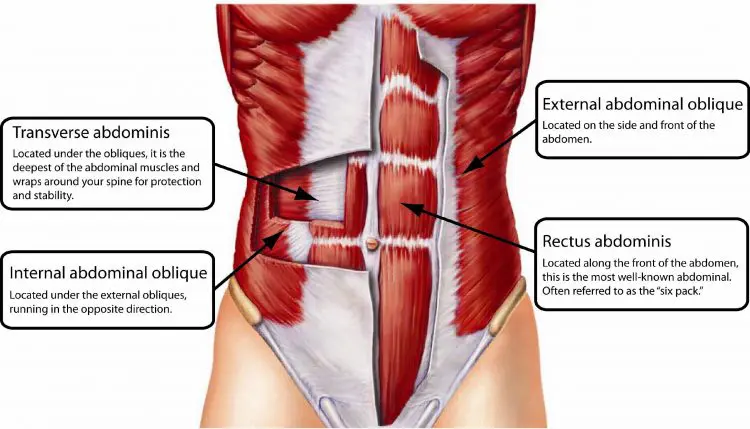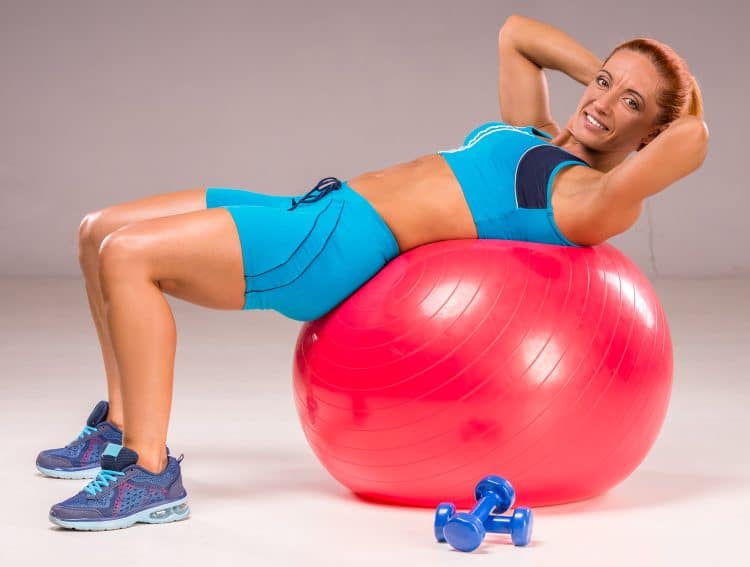How many reps do you do per set for your arm workouts? The answer is probably something like 6-12 reps. What about leg training? It’s likely to be the same answer, but you may go as high as 20 reps for some exercises.
Exercisers use these rep ranges because they provide the ideal balance between mechanical and metabolic stress, both of which are critical for muscle growth.
So why is it that so many people do much higher reps for their abs? It’s not uncommon to see exercisers banging out dozens if not hundreds of reps using next to no resistance.
This approach to abs training is a colossal waste of time!
When it comes to effective strength training, only the last few reps of each set are intense enough to trigger increases in muscle strength and size. If you do 12 reps, the first eight or so are just there to get you to where your muscles begin to fatigue, and that’s your set becomes productive.
Level Up Your Fitness: Join our 💪 strong community in Fitness Volt Newsletter. Get daily inspiration, expert-backed workouts, nutrition tips, the latest in strength sports, and the support you need to reach your goals. Subscribe for free!
If you do a set of 50 reps, you are wasting even more time, as it will just take longer to fatigue your muscles.
Because of this, weighted exercises like cable crunches should be staples of your abs training. Adding weight will save you from doing high reps sets to fatigue your abs. In most cases, for the sake of workout efficiency, you should try and stick to 20 reps or less per set.
But what if you don’t have a cable machine or are just bored of doing the same old cable crunches? What do you do then?
In this article, we reveal the 10 best cable crunch alternatives for more muscular, better-defined abs.
What are Cable Crunches?

Cable crunches are an isolation exercise for your abs. That means they only involve movement at one joint – your spine. You will see a lot of people doing this exercise by moving their hips too, but that’s a mistake. This takes tension off your abs and places it on your hip flexors instead. Done correctly, only your spine should move.
Because they are an isolation exercise, cable crunches don’t involve many muscles. The primary muscles involved in cable crunches are:
Rectus abdominis – located on the front of your abdomen, the rectus abdominus or abs for short is responsible for flexion and lateral flexion of your spine. In addition, the abs play a part in compressing your abdominal contents.
The rectus abdominis is divided into sections by bands of ligamentous connective tissue called the linea alba, which gives this muscle its distinctive segmented appearance. This is only visible when body fat levels are low enough.
Transverse abdominus – where the rectus abdominis is positioned vertically on the front of your abdomen, the transverse abdominus (TVA) encircles your waistline horizontally. Its primary function is compressing your abdominal contents, which it does to increase intra-abdominal pressure to increase the stiffness of your lumbar spine. Working not unlike a weightlifting belt, TVA helps support and stabilize your spine from within.
10 Best Cable Crunch Alternatives and Substitute
The main advantage of cable crunches is that they allow you to increase the weight so you can fatigue your muscles without having to resort to high reps. However, like any exercise, even cable crunches can lose their potency if you do them too often.
That’s why it’s so useful to know plenty of alternative exercises.
So, whether you are bored of cable crunches or don’t have access to a suitable cable machine, you can use the following exercises to build stronger, thicker, more visible abs. However, if you want better abs definition and get a six-pack, you’ll also need to eat a little less and burn off whatever fat covers your abs.
- Weighted Crunch
- Stability Ball Crunch
- Abs Rollout
- Hanging Leg Raises
- Kneeling Resistance Band Crunch
- Stability Ball Reverse Crunches
- BOSU Cable Crunch
- Single-arm Farmer’s Walk
- Cable Double Crunch
- Machine Crunch
Related: Washboard Abs, The Ultimate Guide
1. Weighted Crunch
If you can comfortably do more than 20 bodyweight crunches, you need to look for ways to make your workout more challenging. If you don’t, you could find yourself wasting a whole lot of time doing high-rep sets. Weighted crunches are a good solution, especially if you don’t have access to a cable machine.
How to do it:
- Lie on your back with your legs bent and feet flat. Hold a weight plate behind your head, across your chest, or out in front of you with your arms straight.
- Exhale and lift your head and shoulders off the floor. Do not move your feet.
- Pause at the top of the movement for 1-2 seconds, inhale, lie back down, and repeat.
- Use a decline bench to make this exercise even harder.
2. Stability Ball Crunch
Stability ball crunches increase your range of motion, which makes them harder than regular floor crunches. In addition, as the ball moves, you’ll have to work a little harder to stabilize your spine, increasing abdominal muscle activation.
How to do it:
- Sit on your stability ball. Lean back and walk your feet forward until the ball fills the curve of your lower back. Place your hands on your temples or across your chest as preferred. Lie back, so your knees, hips, and shoulders form a straight line.
- Exhale, contract your abs and curl your shoulders toward your hips.
- Lie back down, inhale, and repeat.
- You can also do this exercise with weights to make it harder.
3. Abs Rollout
Level Up Your Fitness: Join our 💪 strong community in Fitness Volt Newsletter. Get daily inspiration, expert-backed workouts, nutrition tips, the latest in strength sports, and the support you need to reach your goals. Subscribe for free!
Despite being a bodyweight exercise, abs rollouts are demanding enough to overload your abs quite quickly. You can do rollouts with an abs wheel or, for a more intense workout, using a barbell. It’s also possible to do rollouts using a suspension trainer, stability ball, or even a landmine.
With all types of rollout, you MUST brace your abs and use them to stop lumbar spine extension. If you can do 20 or more kneeling rollouts, you are probably ready to do them standing, which is MUCH more demanding.
Read all about rollouts here.
4. Hanging Leg Raises
When you do crunches, you only have to lift your head and shoulders off the floor. This represents only a modest percentage of your total body weight. With hanging leg raises, you lift your entire lower body, which is about 40% of your body weight.

There are several different hanging leg raise variations, including:
- Bent leg raises
- Straight leg raises
- Toes to bar raises
- Captain’s chair leg raises (bent or straight)
Read all about this effective cable crunch alternative in this detailed guide.
5. Kneeling Resistance Band Crunch
No cable machine? No problem! You can also do kneeling cable crunches using a resistance band. This is an excellent option for home exercisers. You’ll notice that the tension on your abs really peaks as you reach the mid-rep point. Make the most of this by pausing for a couple of seconds in this position.
How to do it:
- Attach your resistance band to a high anchor point. Take one end in each hand and kneel down. Pull the ends of the band down to your shoulders.
- Without sitting back on your heels, flex your spine and pull your shoulders down toward your hips. Form a C-shape with your spine.
- Return to the starting position and repeat.
6. Stability Ball Reverse Crunches
If you’ve mastered regular stability ball crunches and are looking for a new way to test your abs, this could be the exercise for you. It involves lifting your legs, so it’s considerably more challenging than the standard version.
How to do it:
- Sit on your stability ball. Lean back and walk your feet forward until the ball fills the curve of your lower back. Hold onto a sturdy anchor behind your head, such as a squat rack.
- Exhale and contract your abs, lifting your feet off the floor. Curl your hips up toward your shoulders.
- Smoothly lower your legs and repeat.
- Make this exercise harder by a) moving more slowly or b) holding a weight between your feet.
7. BOSU Cable Crunch
BOSU stands for Both Sides Up and is a hemispherical balance ball that can be used for a wide range of exercises. If you find it hard to do cable crunches without cheating, this exercise could be a better, more effective option. While it works best with a BOSU, you could also do this exercise using a regular stability ball.
How to do it:
- Place your BOSU on the floor in front of a low pulley machine with the dome uppermost. Attach a rope handle to the cable machine.
- Lie on your back, so the curve of the BOSU sits in the arch of your lower back. Plant your feet firmly on the floor and grab the rope handles. Pull the handles into your shoulders.
- Exhale and flex your spine, drawing your shoulders down toward your hips.
- Inhale, lie back, and repeat.
8. Single-arm Farmer’s Walk
We’re the first to admit that single-arm farmer’s walks look NOTHING like cable crunches, and yet, they’re an excellent alternative. One of the functions of your rectus abdominis is lateral flexion, which is fitness-speak for bending sideways.
When you do a single-arm farmer’s walk, you’ll need to use your abs to keep your torso upright and resist lateral flexion. As an added benefit, this exercise also works your obliques. So, when you think about it like that, single-arm farmer’s walks are actually a pretty good alternative to cable crunches.
How to do it:
- Pick up a heavy dumbbell or kettlebell and hold it in one hand, with your arm by your sides. Brace your abs and make sure you keep your torso upright – no leaning toward or away from the weight.
- Walk around your training area for as long as you can. Put the weight down as you feel your grip starting to fail.
- Swap hands and repeat.
Read more about farmer’s walks in this detailed guide.
9. Cable Double Crunch
If kneeling cable crunches are no longer much of a challenge, take this advanced abs exercise for a spin. You’ll need a cable crossover to do it, but if you’ve got access to one of these machines, you’re bound to enjoy how this exercise makes your abs feel, both while you work out and afterward, when the inevitable post-training muscle soreness kicks in!
How to do it:
- Using the lowest setting on a cable crossover machine, attach a rope handle to one pully and two ankle cuffs to the other.
- Lie on the floor and attach the cuffs to your ankles and grab the rope handles with your hands. Pull the handles down and into your shoulders.
- Lift your head and shoulders off the floor, bend your legs, and bring your knees and elbows together. Pause for a second in this most-contracted position.
- Extend your arms and legs and repeat.
10. Machine Crunch
If you really want to overload your abs and aren’t overly concerned about functionality or athleticism, machine crunches could be a good option. With machine crunches, you don’t have to worry about things like balance or coordination. Instead, you are free to focus on working your abs as hard as you like.
Crunch machine designs vary from model to model, but most of them are pretty similar and involve flexing your spine against a lever arm attached to a selectorized weight stack.
If you have access to one of these machines, you should find that it lets you train your abs hard and heavy, making it a useful alternative to cable crunches.
Read more about machine crunches here.
More Abs & Core Exercises:
- Hanging Knee Raise Alternatives
- Barbell Exercises For Abs
- Russian Twists
- Best Oblique Exercises
- Bear Crawl Exercise
- Jump Rope Guide
- Calisthenics Abs Workouts
More Alternative Exercises:
- Best Box Jump Alternatives
- Best Alternatives to Lunges for Bad Knees
- Crunches and Sit-Up Alternative
- Triceps Pushdown Alternatives
- Seated Cable Row Alternative
- Romanian Deadlift Alternatives
- Cable Crossover Alternatives
- Hip Thrust Alternatives
- Back Extension Alternatives
- Leg Extension Alternatives
- Leg Curl Alternatives
- Bench Press Alternatives
Wrapping Up
While there is nothing especially wrong with cable crunches, it’s one of those exercises that will soon lose its potency if you do it too often. And, if you train at home or in a garage gym, you might not be able to do it at all.
The good news is that there are plenty of viable alternatives to this exercise, and each one will save you from having to do high-rep sets for your abs workouts. While high-rep sets can work, they waste a lot of time. Remember, only the last few reps of your set are productive, which means that 30 to 50-rep sets are inefficient.
Weighted abs exercises get you close to failure sooner, and that means fewer wasted reps. Use the exercises in this article to carve the perfect midsection in double-quick time!
Interested in measuring your progress? Check out our strength standards for Machine Seated Crunch, Bench Press, Cable Crunch, and more.












